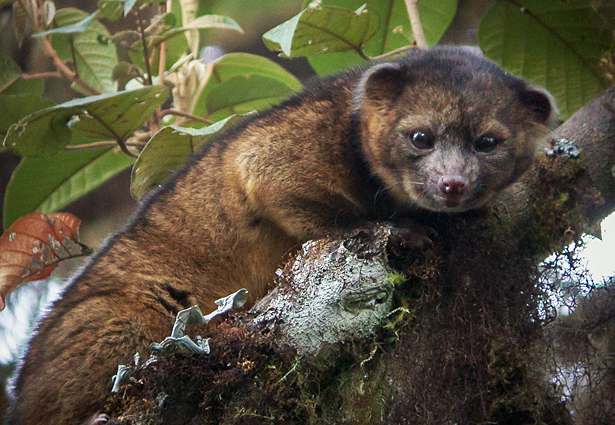New Carnivore in the Cloud Forest

A two-pound mammal that looks like a cross between a house cat and a teddy bear has a claim to fame as the first new carnivore species discovered in the Western Hemisphere in 35 years.
Today, scientists in Washington, D.C., and Raleigh unveiled the olonguito (oh-lin-GHEE-toe), a member of the same family as raccoons, coatis, kinkajous and olingos. The tree-dwelling olinguito lives in the cloud forests of Colombia and Ecuador, high in the Andes Mountains. See the olinguito on this Untamed Science video. You can ask questions during a Google hangout with scientists broadcast Friday at 11 a.m. (English) or 11:30 a.m. (Spanish).
Zoologist Roland Kays, an NC State faculty member and biodiversity lab director at the North Carolina Museum of Natural Sciences, helped track down the olinguito in the wild. The expedition was prompted by a fresh look at museum specimens. Skins and skeletons showed distinct characteristics of a new animal.
“The data from the old specimens gave us an idea of where to look, but it still seemed like a shot in the dark,” Kays says. “But these Andean forests are so amazing that even if we didn’t find the animal we were looking for, I knew our team would discover something cool along the way.”

A few seconds of grainy video shot by a colleague in Ecuador confirmed the olinguito’s existence in the cloud forest. Team members set out on a three-week expedition to document the habits of the large-eyed creature with orange-brown fur. They learned that the olinguito rarely leaves the trees, where it is active mostly at night. Its diet is mostly fruit, and it has one offspring at a time.
“Proving that a species exists and giving it a name is where everything starts,” says Kristofer Helgen, curator of mammals at the Smithsonian’s National Museum of Natural History and leader of the team reporting the olinguito’s discovery. “This is a beautiful animal, but we know so little about it. How many countries does it live in? What else can we learn about its behavior? What do we need to do to ensure its conservation?”
Helgen says the team is planning another mission into the Andean cloud forests, a critical habitat with species found nowhere else in the world. “If new carnivores can still be found, what other surprises await us?”
- Categories:


